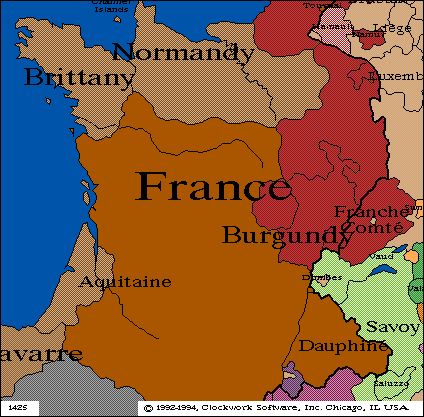|
|
|
|
|
|
|
|
THE ENGLISH EXPANSION (1397 - 1428) |
| BACKGROUND | 1337 - 1360 | 1360 - 1396 | 1397 - 1428 | 1429 - 1453 | AFTERMATH |
|
| HOME | |
|
|
When Henry V became king,
the Lancastrian dynasty was secure enough for him to spend much of his
reign campaigning in France. He
was already experienced in war and government, and immediately began
military preparations. When
the French refused his vast territorial demands, he invaded in 1415.
By June he had decided to besiege the key Norman port of Harfleur.
The siege took five weeks, much longer than Henry had anticipated,
and cost him many men. With a
reduced army he then decided to ride 120 miles, across hostile land to
Calais. French occupation of
the Somme crossing forced a wide detour, and it was a tired and hungry
army which faced the French near Agincourt.
French blunders and the traditional virtues of English men at arms
and archers brought Henry a great victory.
With the death of some 600 French nobles and knights, and the
capture of over 1,000 more, deprived them of leaders and made them
unwilling to face Henry in battle.
The destruction of the French flotilla based at Honfleur (June 29 1417) made the channel safe for English shipping for several years. In August, Henry landed with a large army, his strategy was to isolate western Normandy first. It took a month to capture Caen, a useful port. He then secured the southern border. The neighbouring princes sued for peace. In the following spring, the western fortresses were mopped up. Only Domfront and Cherboug resisted for long. |
|
By early summer, the way to the Seine had been cleared. By January 1419, Rouen had fallen and Normandy north of the Siene quickly fell. The strongholds towards Paris quickly fell. Henry then spent the rest of 1419 negotiating with quarrelling French factions. Burgundy’s murder of the Armagnac leader, brought the crown within his grasp. The treaty of Troyes (May 21 1420) was a peace treaty. It made Henry V regent of France and Charles VI’s heir, and committed Henry and Philip, the new duke of Burgundy, to conquer central and southern France from the dauphin Charles. Two days after marrying princess Katherine, Henry set out to reduce the dauphinists strongholds south of Paris. Melun surrendered in November 1420. Paris was part of England again. By his death in August 1422, apparently of dysentery, only Guise, Le Crotoy and St Valery-sur-somme remained in dauphinists hands in northern France. |
|
|
Henry’s vision of conquering France was unrealistic. In England there was waning enthusiasm for funding what became a French cival war, and most Frenchman saw the dauphin as the rightful heir. Charles VI died two months after Henry. The infant Henry VI of England and the dauphin Charles VII were both declared king of France by their partisans. Henry VI uncle, the duke of Bedford, took command in France. However, England and Lancastrian France no longer has a single government. The duke of Burgundy at best was a lukewarm ally, interested mainly in expanding in the Netherlands. Lancastrian France continued to secure land. However, the French seized Meulan in 1423 and Gaillen in 1424, both on the Siene below Paris showed the vulnerability of Lancastrian Normandy. The French lacked manpower, despite reducing the Norman garrisons, they were not helped by the defection of Brittany and the revolt in Maine. England next operation was to launch an attack across the river Loire against Orleans in 1428.
|
 |